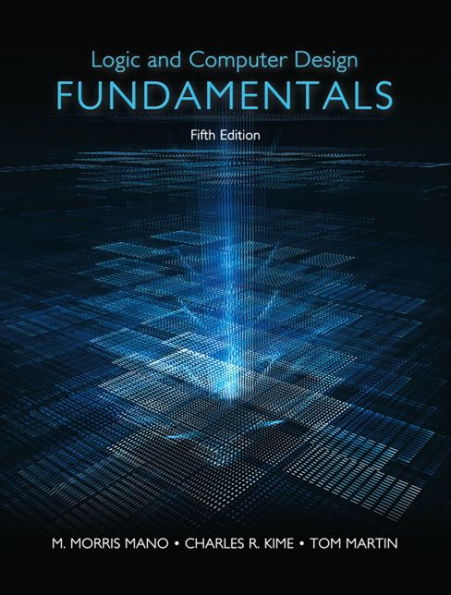Table of Contents
1. Digital Systems and Information
1-1 Information Representation
1-2 Abstraction Layers in Computer Systems Design
1-3 Number Systems
1-4 Arithmetic Operations
1-5 Decimal Codes
1-6 Alphanumeric Codes
1-7 Gray Codes
1-8 Chapter Summary
2. Combinational Logic Circuits
2-1 Binary Logic and Gates
2-2 Boolean Algebra
2-3 Standard Forms
2-4 Two-Level Circuit Optimization
2-5 Map Manipulation
2-6 Exclusive-OR Operator and Gates
2-7 Gate Propagation Delay
2-8 Hardware Description Languages Overview
2-9 HDL Representations—VHDL
2-10 HDL Represenations—Verilog
2-11 Chapter Summary
3. Combinational Logic Design
3-1 Beginning Hierarchical Design
3-2 Technology Mapping
3-3 Combinational Functional Blocks
3-4 Rudimentary Logic Functions
3-5 Decoding
3-6 Encoding
3-7 Selecting
3-8 Iterative Combinational Circuits
3-9 Binary Adders
3-10 Binary Subtraction
3-11 Binary Adder-Subtractors
3-12 Other Arithmetic Functions
3-13 Chapter Summary
4. Sequential Circuits
4-1 Sequential Circuit Definitions
4-2 Latches
4-3 Flip-Flops
4-4 Sequential Circuit Analysis
4-5 Sequential Circuit Design
4-6 State-machine Diagrams and Applications
4-7 HDL Representation for Sequential Circuits—VHDL
4-8 HDL Representation for Sequential Circuits—Verilog
4-9 Flip-Flop Timing
4-10 Sequential Circuit Timing
4-11 Asynchronous Interactions
4-12 Synchronization and Metastability
4-13 Synchronous Circuit Pitfalls
4-14 Chapter Summary
5. Digital Hardware Implementation
5-1 The Design Space
5-2 Programmable Implementation Technologies
5-3 Chapter Summary
6. Registers and Register Transfers
6-1 Registers and Load Enable
6-2 Register Transfers
6-3 Register Transfer Operations
6-4 Register Transfers in VHDL and Verilog
6-5 Microoperations
6-6 Microoperations on a Single Register
6-7 Register-Cell Design
6-8 Multiplexer and Bus-Baed Transfers for Multiple Registers
6-9 Serial Transfer and Microoperations
6-10 Control of Register Transfers
6-11 HDL Representation for Shift Registers and Counters—VHDL
6-12 HDL Representation for Shift Registers and Counters—Verilog
6-13 Microprogrammed Control
6-15 Chapter Summary
7. Memory Basics
7-1 Memory Definitions
7-2 Random-Access Memory
7-3 SRAM Integrated Circuits
7-4 Array of SRAM ICs
7-5 DRAM ICs
7-6 DRAM Types
7-7 Arrays of Dynamic RAM ICs
7-8 Chapter Summary
8. Computer Design Basics
8-1 Computer Design Basics
8-2 Datapaths
8-3 The Arithmetic/Logic Unit
8-4 The Shifter
8-5 Datapath Representation
8-6 The Control Word
8-7 A Simple Computer Architecture
8-8 Single-Cycle Hardwired Control
8-9 Multiple-Cycle Hardwired Control
8-10 Chapter Summary
9. Instruction Set Architecture
9-1 Computer Architecture Concepts
9-2 Operand Addressing
9-3 Addressing Modes
9-4 Instruction Set Architectures
9-5 Data-Transfer Instructions
9-6 Data-Manipulation Instructions
9-7 Floating-Point Computations
9-8 Program Control Instructions
9-9 Program Interrupt
9-10 Chapter Summary
10. RISC and CISC Processors
10-1 Pipelined Datapath
10-2 Pipelined Control
10-3 The Reduced Instruction Set Computer
10-4 The Complex Instruction Set Computer
10-5 More on Design
10-6 Chapter Summary
11. Input-Output and Communication
11-1 Computer I/O
11-2 Sample Peripherals
11-3 I/O Interfaces
11-4 Serial Communication
11-5 Modes of Transfer
11-6 Priority Interrupt
11-7 Direct Memory Access
11-8 Chapter Summary
12. Memory Systems
12-1 Memory Hierarchy
12-2 Locality of Reference
12-3 Cache Memory
12-4 Virtual Memory
12-5 Chapter Summary






